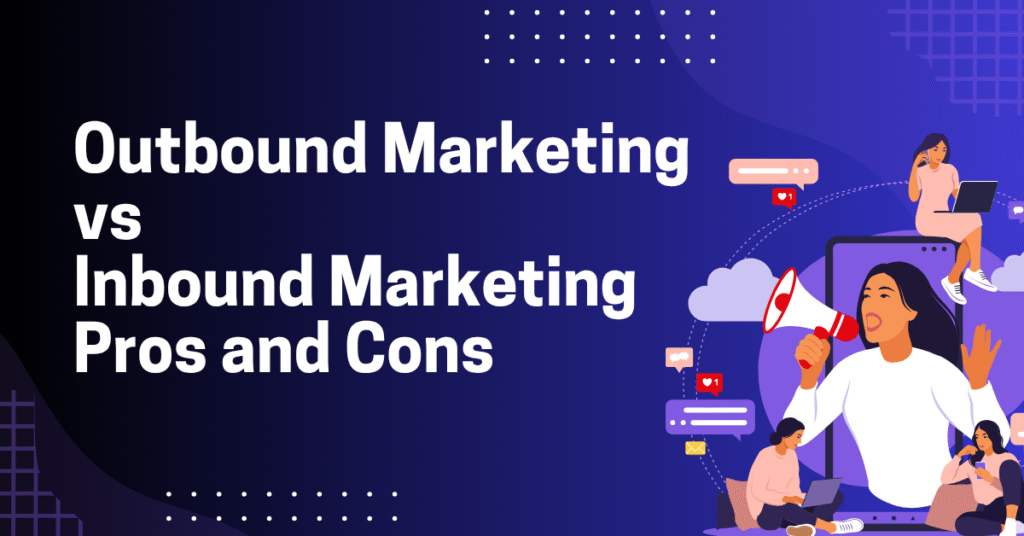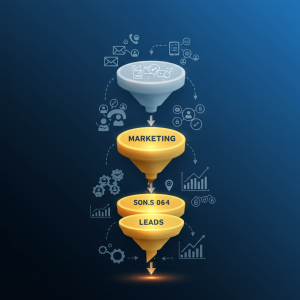Outbound Marketing vs Inbound Marketing Pros and Cons

Marketing is the lifeblood of any successful business. But when it comes to crafting a winning strategy, the age-old debate of outbound marketing versus inbound marketing often takes center stage. Both approaches have unique strengths and challenges that make them suited to different needs and goals.
Whether you’re looking to expand your audience, boost conversions, or refine your brand presence, understanding the pros and cons of outbound and inbound marketing can help you make informed decisions. This blog will break down the essentials of each approach and provide actionable insights to help you determine the best fit for your business.
What is Outbound Marketing?
Outbound marketing, often referred to as traditional marketing, involves proactively reaching out to potential customers to share your message. It’s a more interruptive strategy, relying on advertisements, cold calls, direct mail, and other methods to capture attention.
Pros of Outbound Marketing
- Faster Results
Outbound marketing can deliver quick results because it directly places your message in front of your target audience. If you need immediate visibility or quick sales, outbound marketing strategies like email prospecting or TV ads can help you achieve that.
- Broad Reach
Channels like TV, radio, and billboards allow you to reach a wide audience, which can be particularly useful for building brand awareness quickly.
- New Audience Exposure
Outbound marketing introduces your business to people who may not be actively looking for your product or service. By reaching out to them directly, you can tap into previously untouched markets.
- Measurable Campaigns
Tools like customer relationship management (CRM) software and tracking codes make it easier to monitor outbound campaigns and measure their success. For example, tracking email open rates or tracking landing page visits from paid ads offers data to refine your strategy.
Cons of Outbound Marketing
- High Cost
Outbound tactics such as TV ads, direct mail, and sponsored events can be expensive. Small businesses with limited budgets may find it challenging to compete on an outbound marketing playing field.
- Interruptive
By its nature, outbound marketing interrupts the audience with a message they weren’t necessarily seeking. This can sometimes lead to frustration, such as when customers receive cold calls or see irrelevant ads.
- Lower Engagement
Audiences are becoming more resistant to traditional advertising, especially with the rise of ad-blocking technologies and the ability to skip TV ads on streaming platforms.
- Declining Effectiveness
Today’s consumers are more savvy and skeptical of pushy sales tactics. Modern buyers often prefer to research solutions on their own, making outbound techniques less effective in certain markets.
What is Inbound Marketing?
Inbound marketing, on the other hand, focuses on creating valuable content and resources that attract customers to your brand organically. It involves tactics like blogging, search engine optimization (SEO), social media marketing, and email nurturing.
Pros of Inbound Marketing
- Cost-Effective
Compared to outbound marketing, inbound marketing often requires smaller budgets. Content creation and SEO may require an initial investment of time and resources, but they yield results for the long term.
- Audience Targeting
With inbound marketing, you can create highly targeted content tailored to your ideal audience. For example, blog posts and free resources are designed to answer specific queries, attracting an audience that is already interested in your product or service.
- Builds Trust and Authority
By consistently providing valuable, informative content, you establish your brand as a trusted expert in your industry. Over time, this builds stronger customer relationships and fosters loyalty.
- Long-Term Benefits
Once created, inbound marketing assets like blog posts, YouTube videos, or downloadable guides continue to attract traffic month after month, compounding their value over time.
- Customer Engagement
Thanks to blogs, social media, and email marketing, inbound marketing creates opportunities for deeper engagement and personalized interactions with your audience.
Cons of Inbound Marketing
- Takes Time
Building an audience and establishing trust through inbound marketing is a marathon, not a sprint. Results like higher website traffic or improved lead generation can take months.
- Requires Ongoing Effort
Success with inbound marketing depends on consistent effort. You’ll need to produce regular content, maintain a strong social media presence, and continually optimize your SEO efforts.
- Competition
The internet is flooded with content, which means standing out requires a strategic approach and a unique value proposition.
- Can Be Technical
Elements like SEO and content management can require technical know-how, which may need additional training or the hiring of specialists.
How Outbound and Inbound Work Together
While they’re often seen as opposites, outbound and inbound marketing don’t necessarily need to operate in isolation. The most successful businesses often combine the two to create a robust, multi-channel strategy. Here’s how they can complement each other:
- Kick-Start Awareness with Outbound
Outbound marketing can help you quickly raise initial awareness of your brand. For example, a paid ad campaign can direct traffic to a meticulously crafted landing page designed with inbound marketing principles.
- Use Outbound to Share Content
Promote inbound assets such as blog posts, webinars, or e-books using outbound techniques like social media ads or email campaigns.
- Follow Up with Nurturing
Use inbound techniques like email drip campaigns to nurture leads generated through outbound marketing efforts.
- Target Specific Campaigns
For time-sensitive promotions (like product launches or sales), use outbound tactics to get the word out fast. Then support it with inbound techniques, such as creating a blog post or video that explains the “why” behind the product.
Making the Right Choice for Your Business
Choosing between outbound and inbound marketing ultimately depends on your business goals, audience preferences, and resources. Here are some guidelines to help:
- Use outbound marketing if:
You need immediate results, have substantial ad budgets, and want to reach a wide audience that isn’t actively searching for your solution.
- Use inbound marketing if:
You’re focused on building long-term relationships, have time to grow your audience organically, and want to establish trust and authority within your niche.
That said, for most businesses, a blend of both strategies will deliver the best results. It’s all about finding the right balance.
Take Action on Your Marketing Strategy Today
Understanding the pros and cons of outbound and inbound marketing gives you the tools to make smarter decisions for your business. There’s no one-size-fits-all solution, but by thoughtfully combining the strengths of each approach, you can create a strategy that aligns perfectly with your goals.
Need help refining your marketing strategy? Consider working with experienced professionals who can guide you through optimizing both outbound and inbound efforts. The right strategy will not only amplify your reach but also build a loyal audience keen to engage with your brand.





